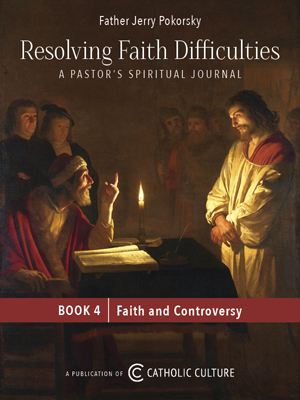Make your gift today!
Help keep Catholics around the world educated and informed.
Already donated? Log in to stop seeing these donation pop-ups.
The End and the Beginning: The Cycle of the Liturgical Year
By Jennifer Gregory Miller ( bio - articles - email ) | Nov 26, 2013 | In The Liturgical Year
I love late autumn in Virginia. The seasonal changes are so tangible: colder nights, bare trees, piles of crunchy dead leaves, shorter days, early and longer darkness, and, the biggest contrast to me, the outdoor silence. There are no birds singing, no crickets chirping, no other creatures making their background noises, and no leaves in the trees for the wind to rustle. All this dying and darkness are reminders of earthly mortality, MY mortality.
Meanwhile, the recurring themes in the Church's Liturgy during November reflect these same changes of the seasons. The prayers and readings focus on death, judgment, heaven, hell, and Purgatory, with an emphasis on the Communion of Saints, for as the Liturgical Year draws to a close, we also consider our final ends. During November my family visits graves of family and friends, combining our nature study time as we explore cemeteries. We become more aware of our suffering brethren on earth (and Purgatory) and strive to make extra sacrifices and prayers on their behalf.
The Liturgical Year culminates in the celebration of the Solemnity of Our Lord Jesus Christ, King of the Universe. Honoring Christ as King is in harmony with the eschatological theme: "[W]e journey toward the consummation of human history, one which fully accords with the counsel of God's love: "To reestablish all things in Christ, both those in the heavens and those on the earth" (Eph. 11:10). The Lord Himself speaks: "Behold I come quickly! And my reward is with me, to render to each one according to his works. I am the Alpha and the Omega, the first and the last, the beginning and the end (Rev. 22:12-13)." (Gaudium et Spes, 45)
This feast marks the end of the Liturgical Year with the tone not of fear or despair, but one of hope. The themes of hope and eschatology continue into the Advent season. We are given a new beginning for self-examination and renewal and to prepare for the two-fold coming: 1) remembrance of Christ's first coming as an infant at Christmas and 2) Christ's Second Coming and our Final Judgment.
Daily living with the Liturgy, going deeper and bringing them to a practical level in our Domestic Church has always been an area of special interest to me, and that's why I'm excited to begin a new blog at Catholic Culture focusing on the Liturgical Year, particularly through living the Liturgy.
I'm not new to this space. I worked with Dr. Mirus off and on for almost 15 years, with my last focus conceiving and helping to build the Liturgical Year section of the site. During my 10 year break my husband Dave and I have concentrated on raising and homeschooling our two sons, ages 10 and 6. I've been able to use this time to put these ideas to work in real family life, and I'm happy to be back.
As the oldest of seven I enjoyed the richness of living the Liturgical Year in our Domestic Church, our home. It was that experience which kindled a lifelong interest. Even before I graduated from high school I began collecting books on the Liturgical Year—many of them out-of-print or hard-to-find. I thought there should be a way to somehow bring together all these various resources while also incorporating new ideas. I also saw a need for something that bridged the gap between pre- and post Vatican II, to show the continuity, but also to reflect changes. These ideas were channeled into Catholic Culture's Liturgical Year section.
"Living the Liturgy" or "living the Liturgical Year" are common phrases in Catholic circles, and the Internet is full lovely ideas of foods, crafts, teas and other family activities for feast days of the Liturgical Year. But I am taking a step back to explain my general philosophy in living the Liturgy in our Domestic Church. First I apply St. Pius X's program as stated in his first encyclical, E Supremi of August 1903, "to restore all things in Christ" (Eph. 1: 10), so that "Christ may be all and in all" (Col. 3:2), continuing with everything beginning with and leading back to the Eucharist, "the source and summit of the Christian life" (or "fount and apex" as the current translation states) (CCC 1324) keeping in mind that the "universal call to holiness" (CCC 2013) includes all of us in every walk and stage of life. I am working for sanctity for myself, my husband and our children, trying to bring us deeper into the Liturgy of the Church, and aiding each family member to develop and deepen their prayer life and relationship with Christ.
It is such a blessing to be part of Catholic Church. She is often referred to as "Mother Church"—and truly, what a good Mother she is! In all aspects She keeps in mind our needs as a whole person. Because we are physical beings, the Liturgy incorporates all our senses, having external components to bring us to the spiritual. We want life in our Domestic Church to follow that same pattern, but ensure that the practices are not hollow. The aim is to choose activities that will provide an external reminder of an interior conversation with Christ, thinking of the Benedictine theme "Ora et Labora" (Pray and Work), or Martha's hands with Mary's heart, striving to be "Contemplatives in Action."
Lest you think I'm merely cerebral and idealistic, I must explain I'm very practical in nature and truly seek to adapt our liturgical practical to circumstances and capabilities of our family. When I first got married I tried a myriad of recipes for desserts and breads on special feasts. I had visions of trying all the recipes on Catholic Culture. Four years later our oldest son was diagnosed with severe food allergies, which has significantly curbed my experimenting. I've had to adjust our menu to fit his needs. We can't make all those traditional desserts and foods connected to feast days. Baking becomes an expensive hobby when it can't include wheat, eggs, or milk! So while St. Catherine's Wigs are traditional on her feast day we discuss the traditions and the food, but bypass the actual baking. I have to pick and choose and tweak to make what works for us.
I also look at my own energy levels with realistic expectations. I'm facing open heart surgery in my very near future to correct some genetic problems. My symptoms have seriously curbed many activities because I physically can't do much right now. So right now most of our Liturgical Year celebrations aren't as visible and definitely not photo-worthy. I'm consoled with the fact that the Church repeats the liturgical cycle year after year. There will be repetition, renewal, and more opportunities to deepen our Faith with each cycle.
The next annual cycle begins again with Advent. I am looking forward to the new liturgical season and sharing more thoughts on living the Liturgical Year. Let us together live the Liturgical Year, aiming to think with the Church -- living, feeling, praying, fasting, and feasting. Let us restore a Catholic culture within our homes first, then the world, "renewing all things through Christ."
All comments are moderated. To lighten our editing burden, only current donors are allowed to Sound Off. If you are a current donor, log in to see the comment form; otherwise please support our work, and Sound Off!








